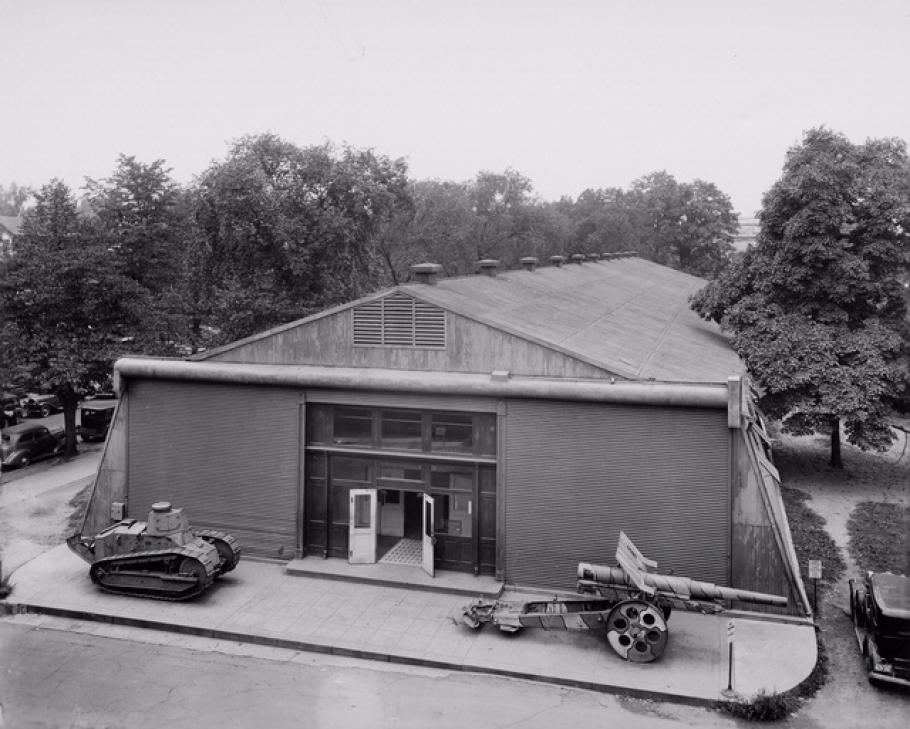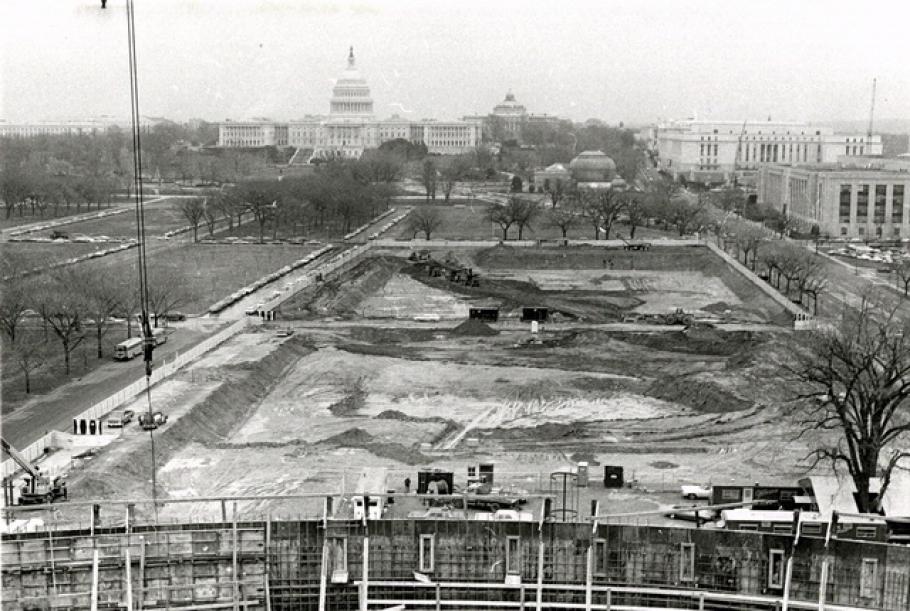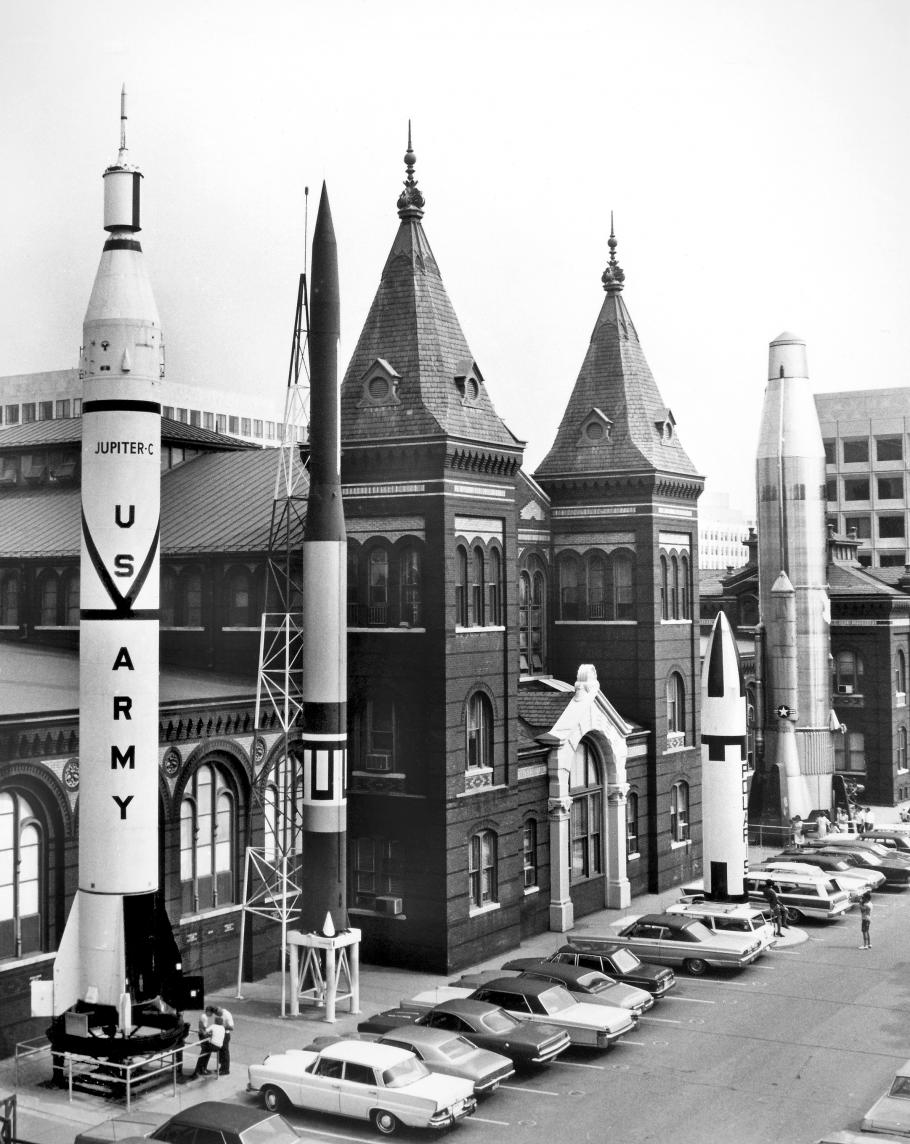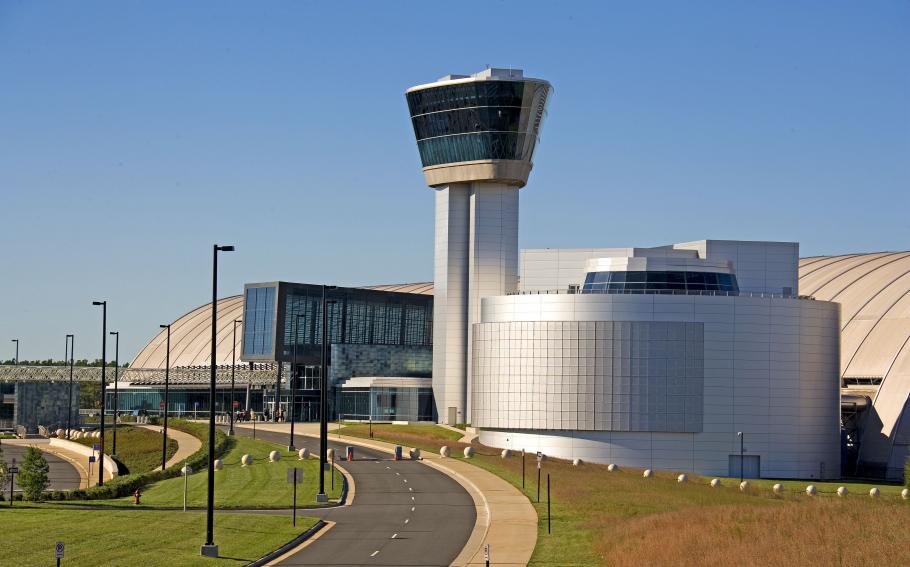The Early Years
The Smithsonian's connection to flight began with the birth of the Institution, first headed by Joseph Henry, a physicist, balloon enthusiast, and sky-watcher. In 1861, Henry made a pivotal contribution to American aviation when he invited Thaddeus Lowe to inflate his hot air balloon on the Smithsonian grounds. This demonstration eventually led to the birth of American aerial reconnaissance during the Civil War.
It is no wonder then, that the Smithsonian's aeronautical collection began well before 1976, when the National Air and Space Museum was constructed on the Mall in Washington, DC. 100 years before, in 1876, twenty beautiful kites were acquired from the Chinese Imperial Commission, seeding what would later become the largest collection of aviation and space artifacts in the world.
The Museum's collections were first housed in the Arts and Industries Building, then after World War I, expanded to a prefabricated metal building erected by the War Department behind the Smithsonian Castle. Affectionately known as the "Tin Shed," the new building opened to the public in 1920 and would remain in use for the next fifty-five years.
The National Air Museum
In 1946, President Harry Truman signed a bill establishing the Smithsonian's National Air Museum to memorialize the development of aviation; collect, preserve, and display aeronautical equipment; and provide educational material for the study of aviation. The legislation didn't provide for the construction of a new building, however, and the collection soon outgrew the existing exhibition space. Since there was no room left in the Arts and Industries Building or the "Tin Shed," World War II aircraft and other items such as engines and missiles were stored at an abandoned aircraft factory in Park Ridge, Illinois, a suburb of Chicago. The U.S. Navy had a similar collection in storage for the Smithsonian at Norfolk, Virginia.
In 1951, as a result of the Korean War, the Museum had to vacate the Park Ridge premises. In response to the immediate need for space, Paul Garber, the National Air Museum's first curator, located twenty-one acres in Silver Hill, Maryland, a suburb of Washington, DC. With the addition of several prefabricated buildings the site became the storage area for the National Air Museum. Garber had managed to save the collection. To honor his achievement, the location was named the Paul E. Garber Preservation, Restoration, and Storage Facility in 1980.
Joining the Space Age
Well before spaceflight became a reality, the Smithsonian took a leading role in funding one of America's most important rocket leaders. In 1916, Robert Goddard wrote to Secretary Charles Greeley Abbot requesting a grant to support his research. The Smithsonian awarded him $5,000 to conduct his first practical experiments in rocketry and eventually published his classic treatise, A Method of Reaching Extreme Altitudes.
Over the next fifty years, as the technology continued to advance, and as the collection expanded to include artifacts related to rocketry and spaceflight, it became clear that the Museum was entering a new phase. In 1966, President Lyndon Johnson signed a law that changed the name of the National Air Museum to the National Air and Space Museum to memorialize the development of both aviation and spaceflight. The Museum's collection on display expanded to include missiles and rockets, some of which were located outdoors near the Arts and Industries Building in an area that was known as "Rocket Row."
Rocket Row along the west side of the Arts and Industries Building before the National Air and Space Museum was built.
Funding to construct a new building was approved in 1971. The location was determined on the National Mall between Fourth and Seventh Streets S.W. Smithsonian Secretary, S. Dillon Ripley, hired former Apollo 11 astronaut Michael Collins as the National Air and Space Museum's first director. Collins would guide the Museum through its construction, hire a team of top-notch professionals, oversee the creation of first-rate exhibits, and launch the Museum's Center for Earth and Planetary Studies. The Center was devoted to active research in analysis of lunar and planetary spacecraft data and the lead for Earth observations and photography from the Apollo-Soyuz Test Project.
Groundbreaking took place on November 20, 1972, and in early 1975 the task of filling the building with air and spacecraft began. The goal of opening during America's bicentennial year was met and the building was inaugurated with great fanfare on July 1, 1976.
The success of the Smithsonian's new National Air and Space Museum exceeded expectations. The five millionth visitor crossed the threshold only six months after opening day. Today, the National Air and Space Museum is one of the most visited museums in the world.
Expansion
Two days before the 100th anniversary of the Wright brothers' historic 1903 flights, the Museum greeted the second century of flight by opening a spectacular new companion museum. Located on the grounds of Washington Dulles International Airport in Northern Virginia, the Steven F. Udvar-Hazy Center dwarfs the Museum in Washington, DC in size. It displays scores of aircraft in its huge Boeing Aviation Hangar and many rockets, missiles, satellites, and other spacecraft in its James S. McDonnell Space Hangar, with more artifacts being moved there all the time. The Center houses a large restoration facility, an archives, collections processing unit, conservation laboratory, and collections storage for small objects.
The Flight Continues
The collection that started in 1876 with a group of 20 kites has grown to nearly 60,000 objects. A large portion of the objects in the collection are on public display, either at the Museum or on loan to other institutions around the world. Many more objects remain in storage. The Museum remains the preeminent American institution for memorializing flight and for collecting, preserving, and presenting aviation and space technology. It also plays a pivotal role in planetary research.
In 2018, the Museum embarked on a multi-year renovation. All 23 exhibitions are being completely reimagined, with the addition of new presentation spaces and attractions.
In 2021, the Smithsonian received a $200 million donation from Jeff Bezos, founder and executive chair of Amazon, and founder of aerospace and space flight company Blue Origin. The donation is the largest gift to the Smithsonian since the Institution’s founding gift from James Smithson in 1846. A portion of the donation will launch a new education center.
What is to come will be limited only by the imaginations of future generations, many of whom will be inspired by a childhood visit to see the remarkable airplanes and spacecraft at the National Air and Space Museum.
Were you involved in the design or construction of the original National Air and Space Museum building in Washington, DC? Share your story with us at preservation@si.edu.
The Early Years
The Smithsonian's connection to flight began with the birth of the Institution, first headed by Joseph Henry, a physicist, balloon enthusiast, and sky-watcher. In 1861, Henry made a pivotal contribution to American aviation when he invited Thaddeus Lowe to inflate his hot air balloon on the Smithsonian grounds. This demonstration eventually led to the birth of American aerial reconnaissance during the Civil War.
It is no wonder then, that the Smithsonian's aeronautical collection began well before 1976, when the National Air and Space Museum was constructed on the Mall in Washington, DC. 100 years before, in 1876, twenty beautiful kites were acquired from the Chinese Imperial Commission, seeding what would later become the largest collection of aviation and space artifacts in the world.
The Museum's collections were first housed in the Arts and Industries Building, then after World War I, expanded to a prefabricated metal building erected by the War Department behind the Smithsonian Castle. Affectionately known as the "Tin Shed," the new building opened to the public in 1920 and would remain in use for the next fifty-five years.
The National Air Museum
In 1946, President Harry Truman signed a bill establishing the Smithsonian's National Air Museum to memorialize the development of aviation; collect, preserve, and display aeronautical equipment; and provide educational material for the study of aviation. The legislation didn't provide for the construction of a new building, however, and the collection soon outgrew the existing exhibition space. Since there was no room left in the Arts and Industries Building or the "Tin Shed," World War II aircraft and other items such as engines and missiles were stored at an abandoned aircraft factory in Park Ridge, Illinois, a suburb of Chicago. The U.S. Navy had a similar collection in storage for the Smithsonian at Norfolk, Virginia.
In 1951, as a result of the Korean War, the Museum had to vacate the Park Ridge premises. In response to the immediate need for space, Paul Garber, the National Air Museum's first curator, located twenty-one acres in Silver Hill, Maryland, a suburb of Washington, DC. With the addition of several prefabricated buildings the site became the storage area for the National Air Museum. Garber had managed to save the collection. To honor his achievement, the location was named the Paul E. Garber Preservation, Restoration, and Storage Facility in 1980.
Joining the Space Age
Well before spaceflight became a reality, the Smithsonian took a leading role in funding one of America's most important rocket leaders. In 1916, Robert Goddard wrote to Secretary Charles Greeley Abbot requesting a grant to support his research. The Smithsonian awarded him $5,000 to conduct his first practical experiments in rocketry and eventually published his classic treatise, A Method of Reaching Extreme Altitudes.
Over the next fifty years, as the technology continued to advance, and as the collection expanded to include artifacts related to rocketry and spaceflight, it became clear that the Museum was entering a new phase. In 1966, President Lyndon Johnson signed a law that changed the name of the National Air Museum to the National Air and Space Museum to memorialize the development of both aviation and spaceflight. The Museum's collection on display expanded to include missiles and rockets, some of which were located outdoors near the Arts and Industries Building in an area that was known as "Rocket Row."
Rocket Row along the west side of the Arts and Industries Building before the National Air and Space Museum was built.
Funding to construct a new building was approved in 1971. The location was determined on the National Mall between Fourth and Seventh Streets S.W. Smithsonian Secretary, S. Dillon Ripley, hired former Apollo 11 astronaut Michael Collins as the National Air and Space Museum's first director. Collins would guide the Museum through its construction, hire a team of top-notch professionals, oversee the creation of first-rate exhibits, and launch the Museum's Center for Earth and Planetary Studies. The Center was devoted to active research in analysis of lunar and planetary spacecraft data and the lead for Earth observations and photography from the Apollo-Soyuz Test Project.
Groundbreaking took place on November 20, 1972, and in early 1975 the task of filling the building with air and spacecraft began. The goal of opening during America's bicentennial year was met and the building was inaugurated with great fanfare on July 1, 1976.
The success of the Smithsonian's new National Air and Space Museum exceeded expectations. The five millionth visitor crossed the threshold only six months after opening day. Today, the National Air and Space Museum is one of the most visited museums in the world.
Expansion
Two days before the 100th anniversary of the Wright brothers' historic 1903 flights, the Museum greeted the second century of flight by opening a spectacular new companion museum. Located on the grounds of Washington Dulles International Airport in Northern Virginia, the Steven F. Udvar-Hazy Center dwarfs the Museum in Washington, DC in size. It displays scores of aircraft in its huge Boeing Aviation Hangar and many rockets, missiles, satellites, and other spacecraft in its James S. McDonnell Space Hangar, with more artifacts being moved there all the time. The Center houses a large restoration facility, an archives, collections processing unit, conservation laboratory, and collections storage for small objects.
The Flight Continues
The collection that started in 1876 with a group of 20 kites has grown to nearly 60,000 objects. A large portion of the objects in the collection are on public display, either at the Museum or on loan to other institutions around the world. Many more objects remain in storage. The Museum remains the preeminent American institution for memorializing flight and for collecting, preserving, and presenting aviation and space technology. It also plays a pivotal role in planetary research.
In 2018, the Museum embarked on a multi-year renovation. All 23 exhibitions are being completely reimagined, with the addition of new presentation spaces and attractions.
In 2021, the Smithsonian received a $200 million donation from Jeff Bezos, founder and executive chair of Amazon, and founder of aerospace and space flight company Blue Origin. The donation is the largest gift to the Smithsonian since the Institution’s founding gift from James Smithson in 1846. A portion of the donation will launch a new education center.
What is to come will be limited only by the imaginations of future generations, many of whom will be inspired by a childhood visit to see the remarkable airplanes and spacecraft at the National Air and Space Museum.
Were you involved in the design or construction of the original National Air and Space Museum building in Washington, DC? Share your story with us at preservation@si.edu.



